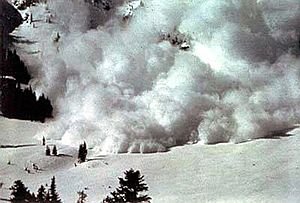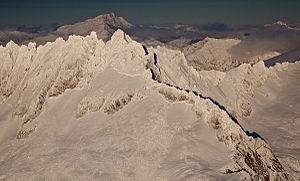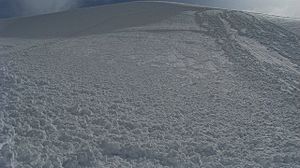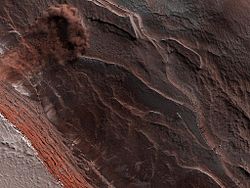Avalanche facts for kids
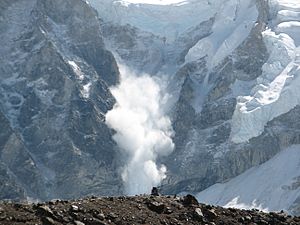
An avalanche is a powerful natural event involving a large amount of snow moving quickly down a mountain. It's like a giant snow slide! When too much snow builds up on a mountain slope, it can suddenly break loose and rush downhill. Avalanches can be very dangerous for skiers and others enjoying winter sports.
Big avalanches can carry stones, boulders, and trees with them. They can bury people under tons of snow. If people are not found quickly by rescue teams, they might not get enough air (suffocation) or become too cold (hypothermia).
The chance of surviving an avalanche depends on how fast someone is found:
- 92% chance if found within 15 minutes.
- 30% chance if found within 35 minutes (people often die from not getting enough air).
- Almost zero chance after two hours (people die from injuries and freezing cold).
Contents
How Avalanches Form
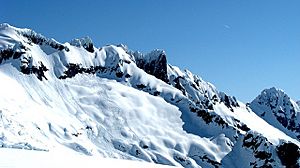
Most avalanches happen naturally during snowstorms. The weight of new snow can make the old snow unstable. Other natural causes include snow melting from the sun, rain, earthquakes, or falling rocks and ice. People can also trigger avalanches, for example, skiers, snowmobilers, or even controlled explosions used to make slopes safer. It's a common myth that loud sounds cause avalanches, but this is not true. The sound pressure is far too weak.
An avalanche can start with just a small amount of snow moving. But if the snow is packed into a stiff layer (a "slab") over a weak, soft layer, a crack can spread very fast. This can cause a huge amount of snow, sometimes thousands of cubic meters, to start moving all at once.
Snow on a slope becomes unstable when its weight is more than the snow can hold. The weight is easy to understand. But how strong the snow is can be very tricky to figure out. Snow strength changes with the type of snow crystals, how dense it is, its temperature, and how much water it contains. Scientists study how snow changes over time to better predict avalanches.
Slab Avalanches
Slab avalanches are common where wind has moved and packed snow. They look like a big block or "slab" of snow that has broken away from the mountain. You can often see clear break lines at the top and sides. These slabs can be from a few centimeters to three meters thick. Slab avalanches cause about 90% of deaths for people in the backcountry (areas away from ski resorts).
Powder Snow Avalanches
The biggest avalanches are often called powder snow avalanches. They create a huge cloud of snow dust that rushes down the mountain. These can happen with any type of snow but are most common with fresh, dry powder. They can move incredibly fast, over 300 kilometres per hour (190 mph), and weigh millions of tons. They can travel long distances, even on flat ground or slightly uphill.
Wet Snow Avalanches
Wet snow avalanches are different. They are slower, moving at about 10–40 km/h. They are a mix of snow and water, and they usually stay close to the ground. Even though they are slow, they are very powerful because they are so heavy and dense. They can clear away rocks, dirt, and trees, leaving bare ground behind. Wet snow avalanches happen when the snowpack is full of water and has reached its melting point. They are often seen at the end of winter when the days get warmer.
Avalanche Pathway
An avalanche follows a path down a mountain. This path depends on how steep the slope is and how much snow is involved.
- The Starting Point is where the avalanche begins, usually on slopes that are 30–45 degrees steep.
- The Track is the middle part of the path, where the avalanche speeds up. This is usually on slopes of 20–30 degrees.
- The Runout Zone is where the avalanche slows down and stops. This often happens when the slope becomes less than 20 degrees steep.
These angles can change because every avalanche is unique, depending on the snow and what caused it.
Staying Safe from Avalanches
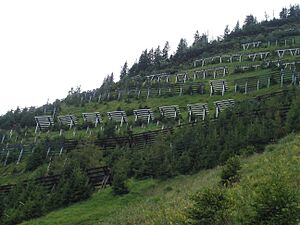
In areas where avalanches happen often, people take steps to reduce damage. For example, they might avoid building houses in these risky spots. Special barriers can also be built to protect areas.
- Some barriers are like big snow nets stretched between poles.
- Other barriers are strong, fence-like structures made of steel, wood, or concrete. These are called snow fences.
Early Warning Systems
Some systems can detect avalanches that form slowly, like ice falling from glaciers. Special radars, cameras, or motion sensors can watch unstable areas for days or even years. Experts look at the data to spot signs of a coming avalanche and take action. These systems can sometimes warn people several days in advance.
Alarm Systems

Modern radar technology can watch large areas and find avalanches day or night, in any weather. Smart alarm systems can detect an avalanche very quickly. This allows roads or railways to be closed, or dangerous areas to be evacuated (emptied of people) within seconds. For example, a system in Zermatt, Switzerland, uses two radars to watch a mountain slope above a road. If an avalanche is detected, the system automatically closes the road with barriers and traffic lights, keeping people safe.
European Avalanche Risk Table
In Europe, the risk of avalanches is rated using a special scale. This scale helps people understand how dangerous conditions are.
| Risk Level | Snow Stability | Avalanche Risk |
|---|---|---|
| 1 - Low | The snow is mostly very stable. | Avalanches are unlikely. They might only happen if a lot of weight is put on very steep slopes. Any natural avalanches will be small. Generally, conditions are safe. |
| 2 - Limited | On some steep slopes, the snow is only somewhat stable. Elsewhere, it is very stable. | Avalanches might be triggered if a lot of weight is added, especially on certain steep slopes. Large natural avalanches are not expected. |
| 3 - Medium | On many steep slopes, the snow is only somewhat or weakly stable. | Avalanches can be triggered on many slopes even with just a little weight. Some medium or even fairly large natural avalanches might occur. |
| 4 - High | On most steep slopes, the snow is not very stable. | Avalanches are likely to be triggered on many slopes even with just a little weight. In some places, many medium or large natural avalanches are likely. |
| 5 - Very High | The snow is generally unstable everywhere. | Even on gentle slopes, many large natural avalanches are likely to occur. |
What these terms mean:
- Stability: This describes how firm the snow is. More details are usually given in the avalanche forecast.
- Additional load: This means extra weight put on the snow.
- Gradient: This refers to how steep the slope is.
- Gentle slopes: Less than about 30 degrees.
- Steep slopes: Over 30 degrees.
- Very steep slopes: Over 35 degrees.
- Extreme steep slopes: Over 40 degrees, or with difficult terrain.
Avalanche Size:
| Size | Runout (how far it travels) | Potential Damage | Physical Size |
|---|---|---|---|
| 1 - Sluff | A small snow slide that cannot bury a person, but you could fall. | Relatively harmless to people. | length less than 50 m volume less than 100 m³ |
| 2 - Small | Stops within the slope. | Could bury, injure, or kill a person. | length less than 100 m volume less than 1,000 m³ |
| 3 - Medium | Runs to the bottom of the slope. | Could bury and destroy a car, damage a truck, destroy small buildings, or break trees. | length less than 1,000 m volume less than 10,000 m³ |
| 4 - Large | Runs over flat areas (less than 30 degrees) for at least 50 m, may reach the valley bottom. | Could bury and destroy large trucks, trains, big buildings, and forests. | length more than 1,000 m volume more than 10,000 m³ |
Famous Avalanches
- In March 1910, two avalanches hit the Cascade and Selkirk Mountain ranges. The Wellington avalanche in Washington state, United States, killed 96 people. A few days later, the Rogers Pass avalanche in British Columbia, Canada, killed 62 railroad workers.
- During World War I, many soldiers died from avalanches in the Alps mountains. It's thought that 40,000 to 80,000 soldiers died from avalanches on the Austrian-Italian front. Many were caused by artillery fire. About 10,000 soldiers died in December 1916 alone.
- In the winter of 1950–1951, about 649 avalanches happened across the Alps in Austria, France, Switzerland, Italy, and Germany. This period was called the "Winter of Terror" because it killed around 265 people.
- In 1990, a mountain climbing camp on Lenin Peak (now in Kyrgyzstan) was destroyed by a huge avalanche triggered by an earthquake. Forty-three climbers died.
- In 1993, the Bayburt Üzengili avalanche killed 60 people in Üzengili, Turkey.
- In 1999, a large avalanche in Montroc, France, slid down a 30-degree slope at about 100 km/h (62 mph). It buried 12 people in their homes under 5 meters (16 feet) of snow.
- Also in 1999, the small Austrian village of Galtür was hit by the Galtür avalanche. The village was thought to be safe, but this avalanche was unusually large and flowed into it. Thirty-one people died.
- On December 1, 2000, the Glory Bowl Avalanche happened on Mt. Glory in the Teton Mountain Range in Wyoming, United States. A snowboarder named Joel Roof accidentally triggered it. He was carried almost 2,000 feet down the mountain and could not be rescued.
Avalanches on the Planet Mars
Images for kids
-
Heavy equipment clearing snow after an avalanche stopped service on the Saint-Gervais–Vallorcine railway in Haute-Savoie, France (2006).
-
In steep areas prone to avalanches, traveling on ridges is usually safer than crossing the slopes.
-
An avalanche path with an 800 metres (2,600 ft) vertical drop in the Glacier Peak Wilderness, Washington state.
-
When surface hoarfrost gets buried by new snowfall, it can become a weak layer that causes upper snow layers to slide.
-
United States Forest Service avalanche danger advisories.
-
Avalanche blasting in the French ski resort Tignes (3,600 m).
-
An avalanche warning sign near Banff, Alberta.
See also
 In Spanish: Alud para niños
In Spanish: Alud para niños


